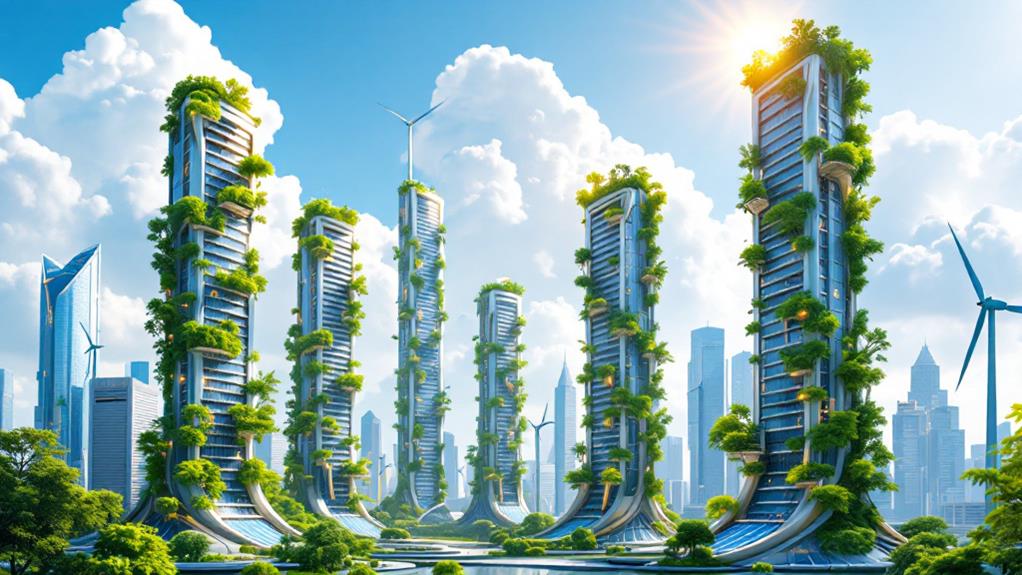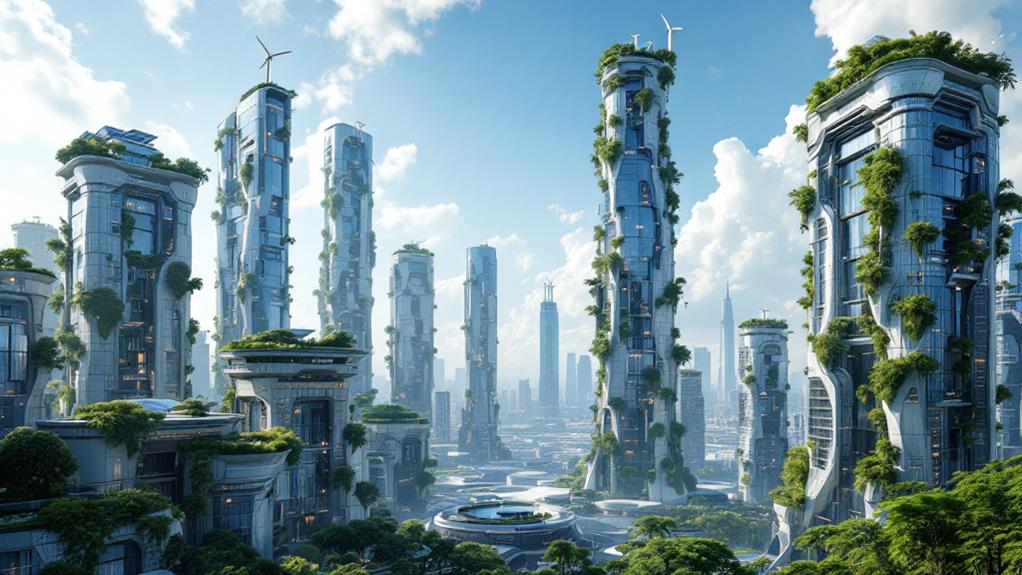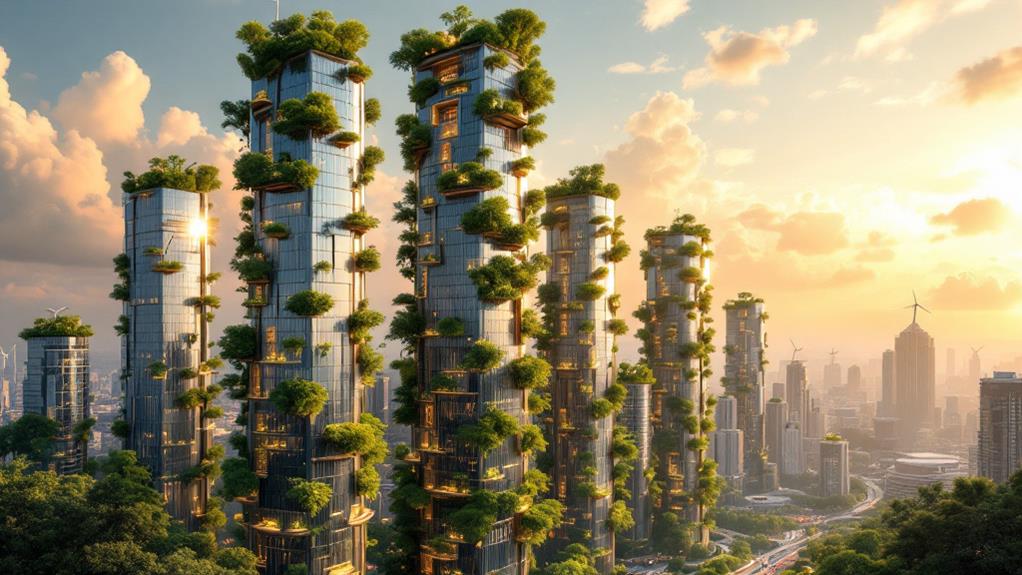Sustainable Design in the World's Largest Buildings

You're witnessing groundbreaking sustainable design at play in some of the world's largest buildings. These architectural wonders integrate cutting-edge technologies and renewable energy sources to minimize environmental footprints. The Taipei Financial Centre cuts energy use by a whopping 33.41 million kWh annually. Shanghai Tower's smart systems and wind turbines reduce its carbon footprint by 34,000 tonnes each year. Meanwhile, One Central Park impresses with its vertical gardens and energy-saving features. These advancements don't just reduce emissions; they also highlight a global trend towards eco-friendly urban architecture. There's much more to investigate about these creative developments.
Iconic Green Structures
Highlighting the pinnacle of sustainable design, iconic green structures redefine what's possible in modern architecture. These sustainable buildings not only transform city skylines but also considerably reduce energy consumption and carbon footprints. The Taipei Financial Centre, the tallest green building globally, exemplifies this by achieving LEED Platinum certification. Its use of energy-efficient lighting and low-flow water fixtures contributes to a whopping 33.41 million kWh reduction in energy use annually.
Meanwhile, Shanghai Tower showcases groundbreaking design through its smart control systems and wind turbines, which together help it cut down its carbon footprint by 34,000 tonnes each year. These systems, along with generating 350,000 kWh of clean energy annually, demonstrate how green architecture can serve both aesthetic and environmental purposes.
In Sydney, One Central Park adopts green architecture with its vertical gardens and rainwater harvesting system, earning a 5-star Green Star rating and reducing energy consumption by 25%. Over in China, Sun-Moon Mansion utilizes over 5,000 solar panels to save an estimated 2.5 tonnes of coal annually. By integrating solar panels and smart systems, these iconic structures highlight the powerful impact of sustainable design in minimizing ecological impact while maximizing efficiency.
Mixed-Use Developments
From iconic green structures, we turn our focus to the groundbreaking domain of mixed-use developments that champion sustainable design. Imagine living in a building that not only meets your urban lifestyle needs but also prioritizes sustainability. One Central Park in Australia exemplifies this with its dual high-rise towers earning a 5-star Green Star rating. It integrates vertical gardens and a water recycling system, setting a benchmark for sustainable urban living.
In Taiwan, the Taipei Financial Centre stands as the tallest green building globally, boasting LEED Platinum certification. By reducing energy consumption by 33.41 million kWh annually, it highlights the efficiency possible in mixed-use design. Meanwhile, China's Sun-Moon Mansion harnesses solar power with over 5,000 solar panels, saving 6.6 million kWh of electricity each year, blending hotel and exhibition spaces in a sustainable way.
The Bahrain World Trade Center is another pinnacle of innovation, using three turbines on sky bridges to capture desert winds, generating 15% of its electricity. These examples show how mixed-use buildings can become lighthouses of sustainability, seamlessly combining energy efficiency and urban convenience with cutting-edge design.
Cutting-Edge Technologies

Cutting-edge technologies in sustainable building design are transforming how we think about energy efficiency and environmental impact. Imagine working in the Shanghai Tower, where smart control systems optimize electricity use, save $556,000 annually, and reduce the carbon footprint by 34,000 tonnes. That's sustainable design at its finest. Or consider the Olympic House in Switzerland, boasting heat pumps that draw energy from Lake Geneva. This setup targets a 35% energy consumption reduction, all while achieving the coveted LEED Platinum certification, setting a high standard for sustainable offices.
In the UK, The Crystal stands as a guiding light of creativity, powered entirely by renewable energy sources. It incorporates ground source heat pumps and a rainwater harvesting system, ensuring its operations remain sustainable. CopenHill in Denmark takes it a step further by merging waste-to-energy technology with recreational space, converting 440,000 tonnes of waste into clean energy annually. Plus, it has an unexpected twist—an inventive ski slope on its roof!
In New York, the Bank of America Tower uses a natural gas-fueled power plant for 70% of its electricity needs, slashing energy consumption and environmental impact. These examples showcase how cutting-edge technologies redefine sustainable building design.
Renewable Energy Integration
Integrating renewable energy into large buildings is transforming the way they function and contribute to sustainability. You'll find that the Shanghai Tower, with its wind turbines, is a prime example of renewable energy integration. These turbines generate about 350,000 kWh annually, cutting energy consumption and leaving a smaller environmental impact. Solar panels are also key players in this green revolution. The Sun-Moon Mansion in China, for instance, uses over 5,000 solar panels, saving 2.5 tonnes of coal and preventing the consumption of 6.6 million kWh of electricity every year.
In Switzerland, the Olympic House showcases sustainable architecture by incorporating solar panels and heat pumps that draw energy from Lake Geneva, slashing energy consumption by 35%. Meanwhile, the Bullitt Center in Seattle stands out with a solar array that not only meets its energy needs but also surpasses them, making it a net-positive energy building. Its rainwater harvesting system further underscores its green building credentials. Ultimately, the Taipei Financial Centre exemplifies energy cost savings through efficient design, reducing its energy consumption by 33.41 million kWh annually. These innovations highlight the potential of renewable energy integration in creating eco-friendly, cost-efficient buildings.
Global Impact and Trends

As the world adopts sustainability, large buildings are at the forefront of global environmental change. You see striking examples like the Shanghai Tower, which uses smart control systems and energy-efficient design to cut its carbon footprint by 34,000 tonnes annually. That's not just environmentally friendly—it saves about $556,000 each year. Meanwhile, Taipei Financial Centre's LEED Platinum certification highlights its commitment to sustainability, reducing energy use by 33.41 million kWh annually and saving over $2 million.
Renewable energy solutions are shaping global trends. Buildings like the Sun-Moon Mansion feature over 5,000 solar panels, generating an impressive 6.6 million kWh annually. On another front, the Bank of America Tower's natural gas-fueled power plant meets 70% of its electricity needs, illustrating a smart approach to reducing environmental impact.
Innovative designs, such as the waste-to-energy systems and vertical gardens at CopenHill and One Central Park, set new benchmarks for urban architecture. These trends reflect a shift towards reducing the carbon footprint and combating climate change. As you investigate these developments, notice how smart control systems and energy-efficient design are central to this sustainable transformation.



